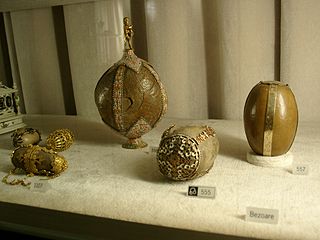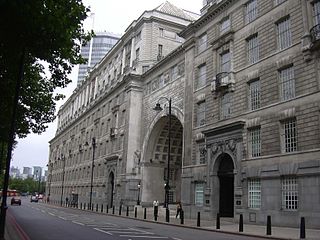Product liability is the area of law in which manufacturers, distributors, suppliers, retailers, and others who make products available to the public are held responsible for the injuries those products cause. Although the word "product" has broad connotations, product liability as an area of law is traditionally limited to products in the form of tangible personal property.
Caveat emptor is Latin for "Let the buyer beware". It has become a proverb in English. Generally, caveat emptor is the contract law principle that controls the sale of real property after the date of closing, but may also apply to sales of other goods. The phrase caveat emptor and its use as a disclaimer of warranties arises from the fact that buyers typically have less information than the seller about the good or service they are purchasing. This quality of the situation is known as 'information asymmetry'. Defects in the good or service may be hidden from the buyer, and only known to the seller.

Step-Saver Data Systems, Inc. v. Wyse Technology was a case in the U.S. Court of Appeals for the Third Circuit primarily concerned with the enforceability of box-top licenses and end user license agreements (EULA) and their place in U.S. contract law. During the relevant period, Step-Saver Data Systems was a value-added reseller, combining hardware and software from different vendors to offer a fully functioning computer system to various end users. Step-Saver's products included software produced by Software Link, Inc (TSL), computer terminals produced by Wyse Technology, and main computers produced by IBM. The fundamental question raised in this case was whether the shrinkwrap licenses accompanying TSL's software were legally binding, given that different terms were negotiated over the phone with Step-Saver prior to receiving physical copies of the software. The case was first heard in the United States District Court for the Eastern District of Pennsylvania, where the court ruled that the shrinkwrap licenses were legally binding. However, the U.S. Court of Appeals for the Third Circuit subsequently reversed this decision, ruling that the shrinkwrap licenses were not legally binding.
The Private Securities Litigation Reform Act of 1995, Pub. L. 104–67 (text)(PDF), 109 Stat. 737 ("PSLRA") implemented several substantive changes in the United States that have affected certain cases brought under the federal securities laws, including changes related to pleading, discovery, liability, class representation, and awards fees and expenses.

Smith v Hughes (1871) LR 6 QB 597 is an English contract law case. In it, Blackburn J set out his classic statement of the objective interpretation of people's conduct when entering into a contract. The case regarded a mistake made by Mr. Hughes, a horse trainer, who bought a quantity of oats that were the same as a sample he had been shown. However, Hughes had misidentified the kind of oats: his horse could not eat them, and refused to pay for them. Smith, the oat supplier, sued for Hughes to complete the sale as agreed. The court sided with Smith, as he provided the oats Hughes agreed to buy. That Hughes made a mistake was his own fault, as he had not been misled by Smith. Since Smith had made no fault, there was no mutual mistake, and the sale contract was still valid.
Stambovsky v. Ackley, 169 A.D.2d 254, commonly known as the Ghostbusters ruling, is a case in the New York Supreme Court, Appellate Division, that held that a house, which the owner had previously advertised to the public as haunted by ghosts, legally was haunted for the purpose of an action for rescission brought by a subsequent purchaser of the house. Because of its unique holding, the case has been frequently printed in textbooks on contracts and property law and widely taught in U.S. law school classes, and is often cited by other courts.
Dennis Jacobs is a senior United States circuit judge of the United States Court of Appeals for the Second Circuit.

L'Estrange v F Graucob Ltd [1934] 2 KB 394 is a leading English contract law case on the incorporation of terms into a contract by signature. There are exceptions to the rule that a person is bound by his or her signature, including fraud, misrepresentation and non est factum.

In Henningsen v. Bloomfield Motors, Inc., 32 N.J. 358, 161 A.2d 69, the New Jersey Supreme Court held that an automobile manufacturer's attempt to use an express warranty that disclaimed an implied warranty of merchantability was invalid.
Laidlaw v. Organ, 15 U.S. 178 (1817), is a case decided by the US Supreme Court that established caveat emptor in the United States.

Ultramares Corporation v. Touche, 174 N.E. 441 (1932) is a US tort law case regarding negligent misstatement, decided by Cardozo, C.J. It contained the now famous line on "floodgates" that the law should not admit "to a liability in an indeterminate amount for an indeterminate time to an indeterminate class."

Chandelor v Lopus (1603) 79 ER 3 is a famous case in the common law of England. It stands for the distinction between warranties and mere affirmations and announced the rule of caveat emptor.

Daulia Ltd v Four Millbank Nominees Ltd [1977] is an English contract law case, concerning unilateral contracts, and when embarking on the performance of an act for which an offer is open, at what point the offer may be withdrawn. In particular, Goff LJ observed that there would be a duty to not prevent full performance of terms in a unilateral offer, once performance had begun.

Contract law regulates the obligations established by agreement, whether express or implied, between private parties in the United States. The law of contracts varies from state to state; there is nationwide federal contract law in certain areas, such as contracts entered into pursuant to Federal Reclamation Law.

Friend v. Childs Dining Hall Co., 231 Mass. 65, 120 N.E. 407 (1918), is part of a progression of cases that influenced the products liability synthesis that emerged in the 1930s. These cases influenced Judge Cardozo's argument in MacPherson v. Buick Motor Co. that a person could be liable for a defective product to someone other than the immediate purchaser. This created the law of product liability.

Chysky v. Drake Bros. Co., 235 N.Y. 468, 139 N.E. 576 (1922), was a products liability case before the New York Court of Appeals. The Court held that a plaintiff cannot recover from a defendant based on implied warranty when she does not have contractual privity with him; thus, a plaintiff cannot recover from a defendant who sold her employer food unfit for consumption, because the defendant's implied warranty extended only to the employer.

Gordon v Selico (1986) 18 H.L.R. 219 is an English contract law on the subject of misrepresentation by action. It was held that positive actions - in this case, the concealment of dry rot - could amount to operative misrepresentations.

Kansas City Wholesale Grocery Co. v. Weber Packing Corp., 93 Utah 414 (1937), was a case decided by the Supreme Court of Utah where the court modified a contract to avoid an unconscionable result.

Holman v Johnson (1775) 1 Cowp 341 is an English contract law case, concerning the principles behind illegal transactions.

Greenman v. Yuba Power Products, Inc, was a California torts case in which the Supreme Court of California dealt with the torts regarding product liability and warranty breaches. The primary legal issue of the case was to determine whether a manufacturer is strictly liable in tort when an article he places on the market proves to have a defect that causes injury to a human being. The case was originally heard in a San Diego district court where the verdict was against the manufacturer. This verdict was appealed by the manufacturer to the Supreme Court of California which was presided by Gibson, C. J., Schauer, J., McComb, J., Peters, J., Tobriner, J., and Peek, J., and the opinion was delivered by Judge Roger J Traynor.













